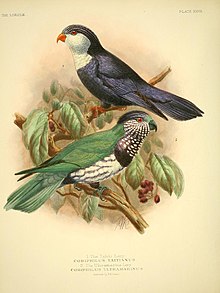Ultramarine lorikeet
| Ultramarine lorikeet | |
|---|---|

| |
| Vini ultramarina (below), with Vini peruviana
| |
| Scientific classification | |
| Domain: | Eukaryota |
| Kingdom: | Animalia |
| Phylum: | Chordata |
| Class: | Aves |
| Order: | Psittaciformes |
| Family: | Psittaculidae |
| Genus: | Vini |
| Species: | V. ultramarina
|
| Binomial name | |
| Vini ultramarina (Kuhl, 1820)
| |
The ultramarine lorikeet (Vini ultramarina) is a species of
critically endangered, threatened mainly by introduction of the black rat and by deforestation
.
Distribution and Population
During the 1970s, the bird was still prevalent on its natural range of
Fatu Hiva, Ua Pou, Nuku Hiva, and Ua Huka in the Marquesas Islands. However, due to heavy deforestation and predation by the invasive black rat and cat
, the ultramarine lorikeet became extinct on Fatu Hiva, Ua Pu, and Nuku Hiva by 2008. Nowadays, the rare bird only remains on Ua Huka. On Ua Huka, the population is estimated to be at about 1,000-2,499 individual birds.

Ecology
Vini ultramarina feeds on a large variety of
Hibiscus tilliaceus
. Little else is little known about this rare species.
Threats
The ultramarine lorikeet is greatly threatened by the predation from the black rat which has greatly decreased its population since its introduction to Nuku Hiva in 1915. All islands have been devastated by extremely high levels of grazing and fire. Most of the original dry forest has been reduced to grassland, and terrible damage has been caused to upland forests as well. Deforestation to make way for farms, logging, and tourism has also had large impact in the decline of its population.
References
- . Retrieved 15 November 2021.
- ^ "Appendices | CITES". cites.org. Retrieved 14 January 2022.

